
A marketing plan is your blueprint for attracting and converting customers. It defines your audience, goals, tactics, budget and success metrics to ensure a focused, measurable approach. The plan often details your:
- Target audience: Who you’re trying to reach
- Marketing goals: What you want to achieve
- Strategies and tactics: How you’ll reach your goals
- Budget: Resources you’ll allocate
- Metrics: How you’ll measure success
The rise of artificial intelligence (AI) is changing the way businesses create their marketing plans today. For example, AI features like automation, predictive analytics and personalization improve marketing processes and support data-driven decision-making.
This guide walks you through the step-by-step process of creating a marketing plan. If you need a headstart, Venngage has professional marketing plan templates designed to make the process much easier.
What is a marketing plan? (+ Examples)
A marketing plan is a report that outlines your marketing strategy for your products or services, which could be applicable for the coming year, quarter or month.
A marketing plan usually includes:
- An overview of your business’s marketing and advertising goals
- A description of your business’s current marketing position
- A timeline of when tasks within your strategy will be completed
- Key performance indicators (KPIs) you will be tracking
- A description of your business’s target market and customer needs
- A description of how you will measure marketing plan performance
For example, this marketing plan template provides a high-level overview of the business and competitors before diving deep into specific goals, KPIs and tactics:
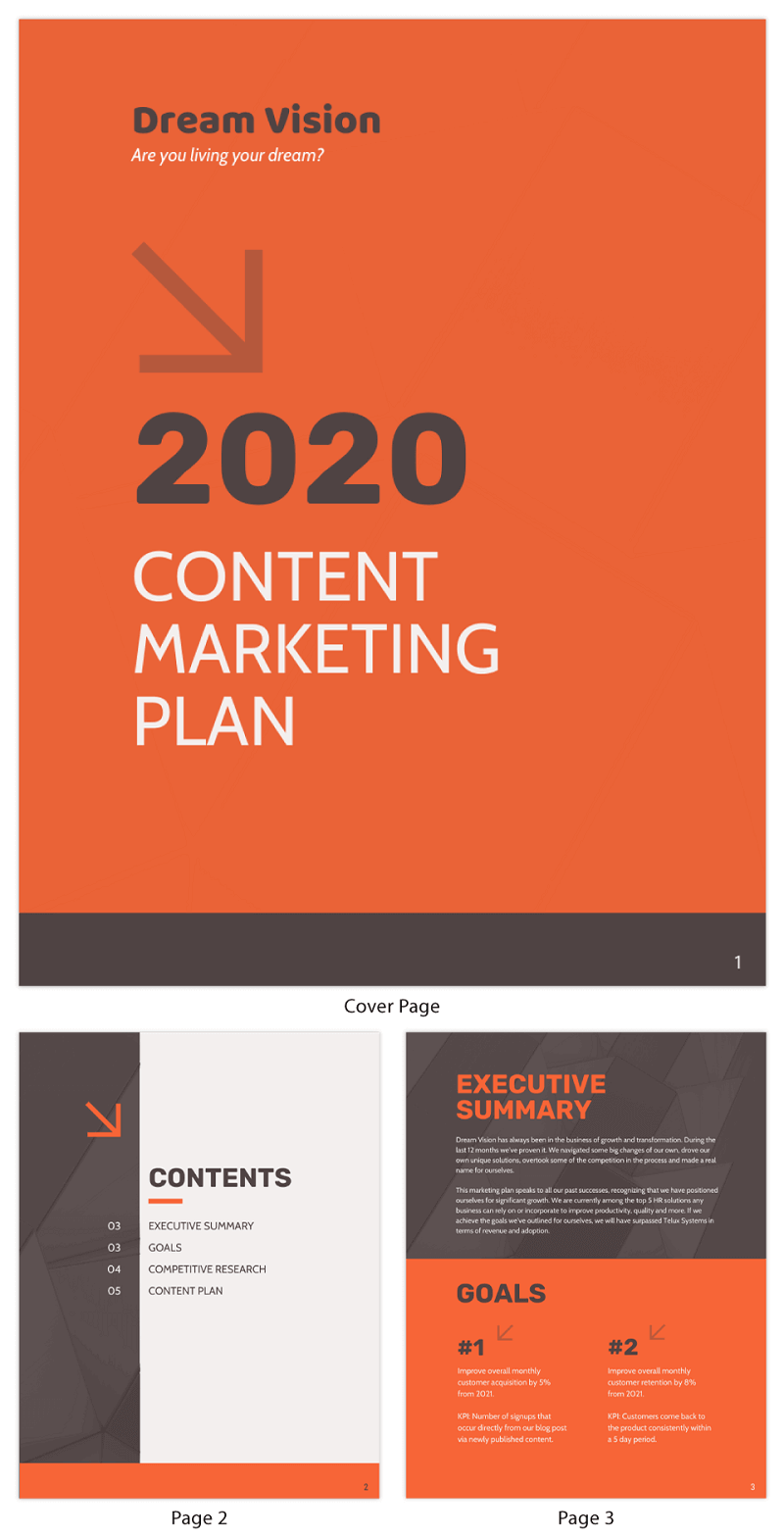
Learning how to write a marketing plan helps you define key steps for an effective marketing strategy. And a well-defined plan keeps you focused on your high-level marketing goals.
With Venngage’s ready-to-use marketing plan templates, creating your marketing plan is quick and easily. Venngage has plenty of helpful communications and design resources for marketers.
Key components of a marketing plan
A good marketing plan gives your business direction and ensures your efforts lead to real results. It helps you stay focused, use resources wisely and adapt to changing trends. Here’s what every marketing plan should include:
Target audience
Target audience, also known as your ideal customer profile or buyer persona, defines who your brand wants to sell to based on their interests, behaviors and demographics. Knowing your target audience helps you create messages that resonate with them.
For example, a fitness brand targeting busy professionals can create content to highlight effective workouts that fit into their schedules.
Marketing goals
Your marketing plan should state what you want to achieve. Whether it’s increasing brand awareness or boosting sales, measurable goals keep your strategy on track, the marketing goals help you focus on what’s important and track progress.
If you own an online takeaway-only food business, for instance, your goal might be to increase online orders by 20% in three months. You can achieve this either through social media ads or local search engine optimization (SEO).
Strategies and tactics
This is your action plan for reaching your target audience and achieving your marketing goals. It includes the marketing channels you’ll use, such as social media, email newsletter, content marketing or paid ads.
It also covers the specific messaging, timing and frequency of your campaigns to ensure consistency. A well-planned strategy helps you engage the right people at the right time with content that resonates. For social media strategies, you can use SocialBee to generate effective, AI-driven plans tailored to your brand.
Budget
Spending blindly on marketing is a fast way to waste money. Setting a clear budget helps you control costs and ensure you invest in what works.
Your marketing plan should cover everything from ad spend and content creation to hiring freelancers and buying new software. This helps you allocate the right resources to high-impact strategies without overspending.
Metrics and tracking
Tracking your results helps you understand what’s working and where to improve. Define key performance indicators (KPIs) like website traffic, conversion rate or social media engagement to measure success.
For example, if you’re running an influencer marketing campaign, monitoring mentions and referral traffic can show whether your collaboration with a specific influencer is effective. Referral tools, like ReferralCandy, make it easy to track metrics like this with built-in referral traffic analytics.
How to write a marketing plan
The scope of a marketing plan varies depending on its purpose or the type of organization it’s for.
For example, digital marketing agencies can develop a marketing plan outlining a company’s entire strategy:

A marketing plan outline often includes:
- Executive summary
- Goals and objectives
- User personas
- Competitor analysis/SWOT analysis
- Baseline metrics
- Marketing strategy
- Performance tracking guidelines
Here’s how to write each part of a marketing plan:
1. Do your market research
Before diving into your marketing strategy, conduct a thorough market research using reliable market research tools. This will help you understand industry trends, customer preferences and your competitive landscape.
The more data you gather, the better you can tailor your marketing efforts to meet audience needs. For deeper insights into how customer information can fuel your strategy, learn about customer data platforms and their benefits for gaining useful insights from raw data.
Market research can include:
- Surveys and customer feedback
- Competitor benchmarking
- Industry trend analysis
- Social listening and sentiment analysis
- Keyword research and SEO trends
Use visuals like charts, infographics or mind maps to make your findings easier to understand. For instance, an infographic summarizing survey responses can help your teams process the complex data easily.
Here’s a template for you to get started easily:
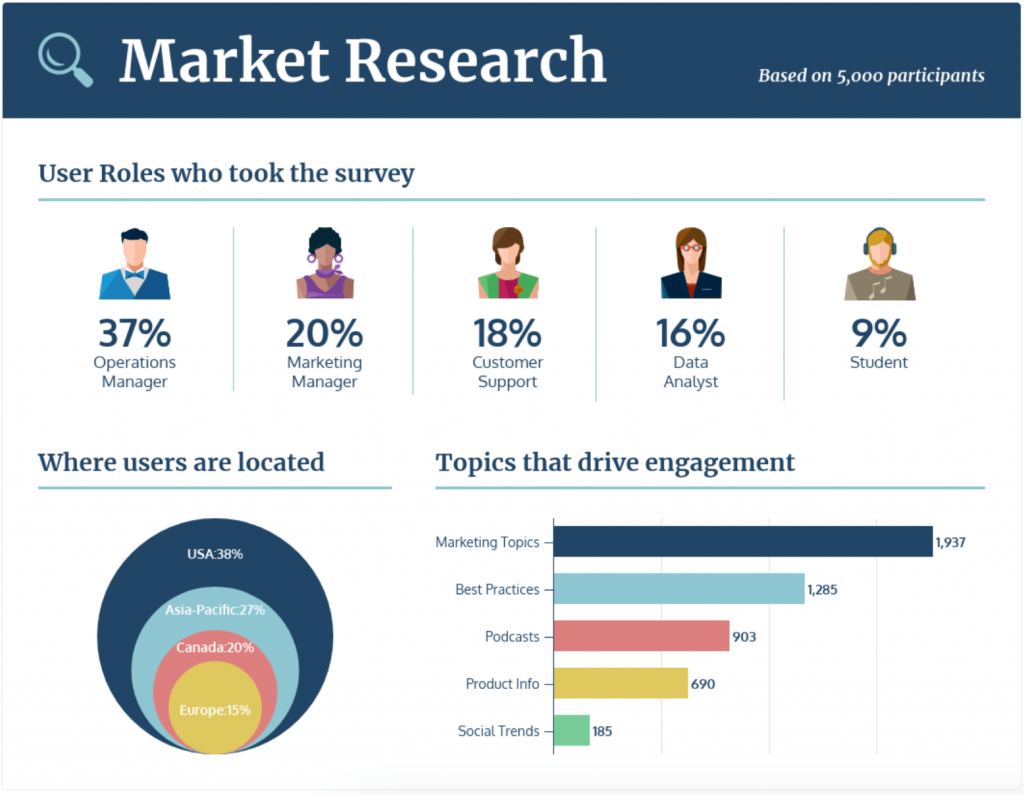
2. Write an executive summary
Starting your marketing plan strong is key — you want to engage your audience, not bore them to tears.
One of the best ways to get people excited to read your marketing plan is with a well-written executive summary. An executive summary introduces readers to your company goals, marketing triumphs, future plans and other important contextual facts.

Use the Executive Summary as a primer for the rest of your marketing plan.
Include things like:
- Long-term marketing goals
- High-level metrics
- Important company milestones
- Facts about your brand
- Employee anecdotes
- Future roadmap
- And more
Keep your executive summary brief and to the point. You aren’t writing a novel, so try to keep it under three to four paragraphs.
Take a look at the executive summary in the marketing plan example below:
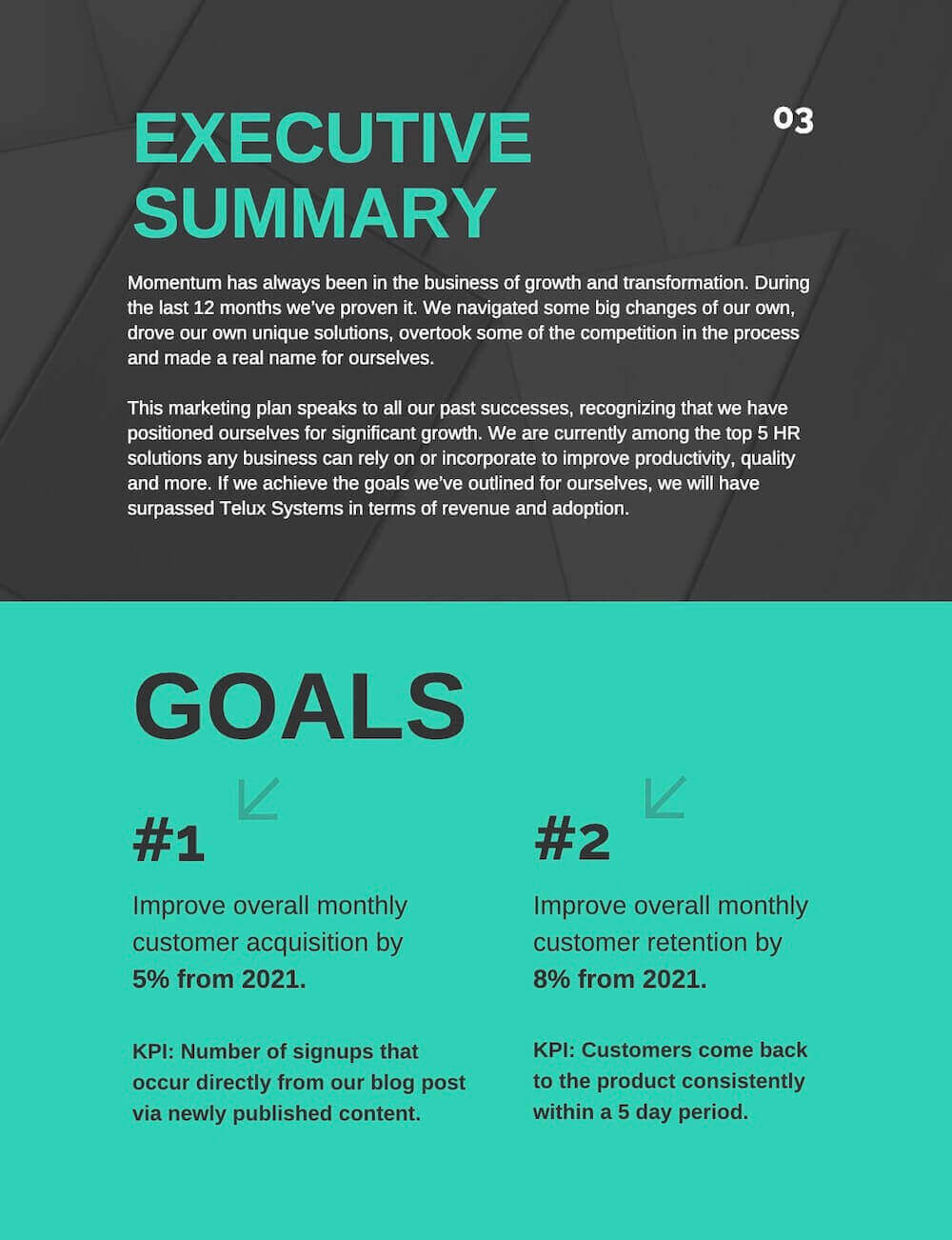
The executive summary is only two paragraphs long — short but effective.
The executive summary also tells readers about the company’s growth and how it has the potential to outpace the competitors. However, it doesn’t mention specific metrics or figures. We will cover it in the next section.
Your executive summary should spark interest without overwhelming the readers. You can cover the remaining details in later sections.
The executive summary also sets the tone for your marketing plan. Think about what tone will fit your brand. Friendly and humorous? Professional and reliable? Inspiring and visionary?
3. Set metric-driven marketing goals
After you perfect your executive summary, it’s time to outline your marketing goals.
If you’re new to setting data-driven goals, read up on how to develop a growth strategy.
Setting clear goals is crucial for your marketing plan, and optimizing your marketing funnel ensures you achieve them effectively. Use effective funnel software, customer success software, and CRO tools to streamline operations and gain valuable customer insights. It will help you track leads, conversion rates and optimize marketing efforts.
As a rule of thumb, be as specific as possible. Set goals that directly impact website traffic, conversions and customer success — backed by real numbers. Meet your conversion goals with website optimization tools like A/B testing tools, heatmaps and session recording software to refine user experience.
Avoid outlining vague goals like:
- Get more Twitter followers
- Write more articles
- Create more YouTube videos
- Double your retention rate
- Reduce bounce rate
Instead, identify key performance metrics (KPIs) you want to impact and the percentage you want to increase them by.
Take a look at the goals page in the marketing plan example below:

It not only specifies a metric for each goal but also sets a timeline for improvement. The same vague goals listed earlier become much clearer when you apply specific numbers and timelines on them:
- Get 1000 new Twitter followers per month
- Write 5 bottom-of-funnel articles per week
- Create 48 YouTube videos each year
- Increase retention rate by 15% by 2026
- Reduce bounce rate by 5% by Q3
You can be as specific as you want about setting your marketing goals. Here’s a marketing plan example that shows how to outline your growth goals:

4. Define your user persona
Outlining your user persona is an important part of a marketing plan that you shouldn’t overlook.
Focus on attracting the right visitors, not just the most visitors, to your business. Who are your ideal customers? What are their goals? What are their biggest problems? How does your business solve customer problems?
Answering these questions will take lots of research, but it’s worth it.
Here are some ways to carry out user research:
- Interview your users
- Conduct focus groups
- Research other businesses in your industry
- Analyze customer feedback and reviews
- Track website analytics and user behavior
- Send out surveys and questionnaires
- Monitor social media discussions and engagement
Next, use the research data to create a user persona. Take a look at how detailed this user persona template is:
Taking the time to identify specific demographic traits, habits and goals will make it easier for you to cater your marketing plan to them.
Here’s how you can create a user persona guide:
Start by adding a profile picture or icon for each user persona. Putting a face to your user persona makes it feel real and relatable.
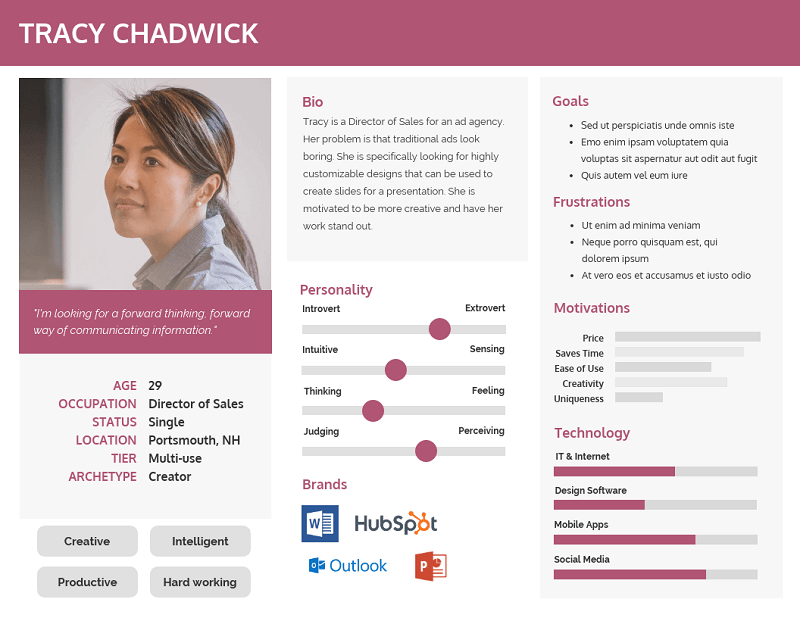
Next, list demographic information like:
- Age
- Gender
- Race
- Job
- Marital status
- Income
- Location
- Education
The user persona example above uses sliding scales to identify personality traits like introversion vs. extroversion and thinking vs. feeling. Identifying your target users’ personalities can help shape the messaging in your marketing content.
This user persona guide identifies specific challenges the users face each day:

If you prefer a simpler approach, you can focus on basic details, like in this example:

Most businesses have multiple target users, which is why it’s important to create distinct user personas. That way, you can segment your marketing campaigns and set separate goals, if necessary.
Here’s a marketing plan example with a segmented user persona guide:

The important thing is for your team or client to have a clear picture of who their target user is and how they can appeal to their specific problems.
A well-defined user persona makes it easier to tailor messaging and strategy. Start creating user personas using Venngage’s user persona guide.
5. Run a competitor analysis
Analyzing your competitive landscape helps you identify competitors, understand their strategies and find opportunities to stand out — or even surpass them. It’s something you can learn to do with a rank-tracking tool.
Competitor research is also incredibly important if you are starting a blog.
Analyzing a competitor usually includes answers abot their:
- Marketing team structure
- Leadership team
- Marketing strategy and strategic plan
- Sales strategy
- Social media approach
- Market cap and financials
- Annual growth
- Customer base and user personas
Also, take as deep a dive as you can into the strategies they use across their:
- Content marketing
- Social media marketing
- SEO marketing
- Video marketing
- Any other marketing tactics
Run a SWOT analysis to identify their strengths and weaknesses and you might find some great opportunities. Use this worksheet to quickly work through all parts of their marketing strategy:

If you have already done your research, adding the findings from your SWOT analysis to your marketing plan should be straightforward.
This marketing plan example outlines high-level research for three competing brands.
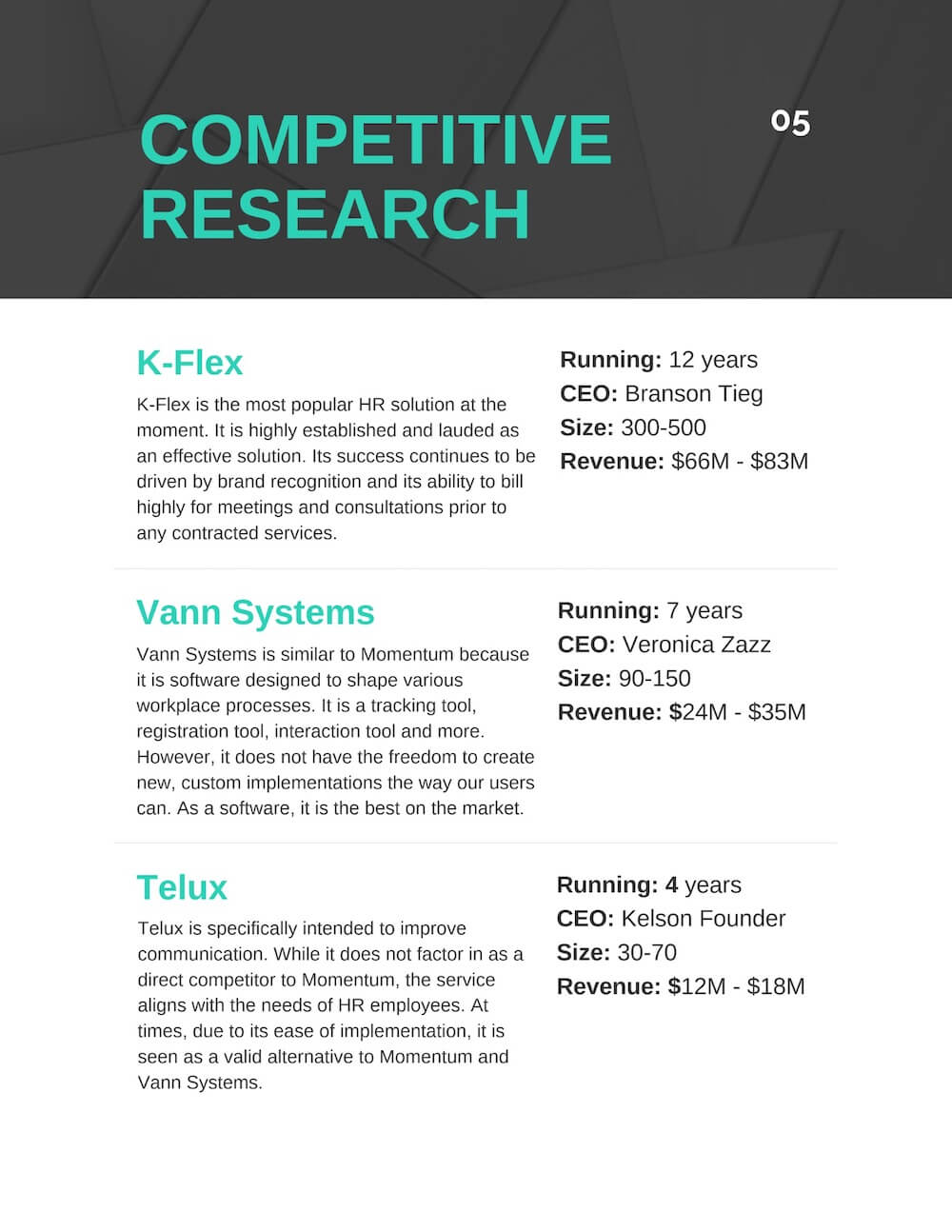
You can dive deeper into different facets of your competitors’ strategies. This marketing plan example analyses a competitor’s inbound marketing strategy:

It can also be helpful to divide your competitors into Primary and Secondary groups. For example, Apple’s primary competitor may be Dell for computers, but its secondary competitor could be a company that makes tablets.
6. Set budget and KPIs
Allocating a budget and setting clear KPIs will help you make your marketing plan both realistic and measurable. Your marketing budget should cover ad costs, content creation, tools and hiring needs. Similarly, KPIs track progress and help optimize campaigns.
Consider the following when setting your budget and KPIs:
- Define a marketing budget with cost breakdowns
- Allocate funds to key channels (social media, paid ads or content marketing)
- Set measurable KPIs (cost per lead, acquisition cost, ROI)
- Track expenses and performance with dashboards or spreadsheets
Visual elements like marketing spend pie charts or KPI tracking dashboards can enhance clarity and keep your team aligned. Including a financial summary with projections can also help secure stakeholder buy-in and keep your marketing efforts accountable.

7. Set baseline metrics
It’s tough to plan for the future if you don’t know where your business stands right now. At Venngage, we always establish baselines first to measure future results.
Setting baselines helps track progress accurately. You will also be able to better analyze what worked and what didn’t, so you can build a stronger strategy. It can help you focus on your goals and strategy.
Here’s a marketing plan example that visualizes the baselines:

Another way to include baselines in your plan is with a simple chart, like in the marketing plan example below:

Because data can be intimidating to a lot of people, visualizing your data using charts and infographics will help demystify the information.
8. Create your marketing strategy
After gathering all the key data and metrics, you can now outline your marketing strategy. Once again, it’s easier to communicate your strategy to your team or clients using visuals.
Mind maps are an effective way to show how a strategy with many moving parts ties together. For example, this mind map shows how the four main components of a marketing strategy interact together:

You can also use a flow chart to map out your strategy by objectives:
No matter how you visualize your strategy, your team must clearly understand their tasks. This may require your strategy section to span several pages, like this marketing plan example shows:

With all of this information, even someone from the engineering or dev team will understand what the marketing team is working on.
This minimalistic marketing plan example uses color blocks to make the different parts of the strategy easy to scan:
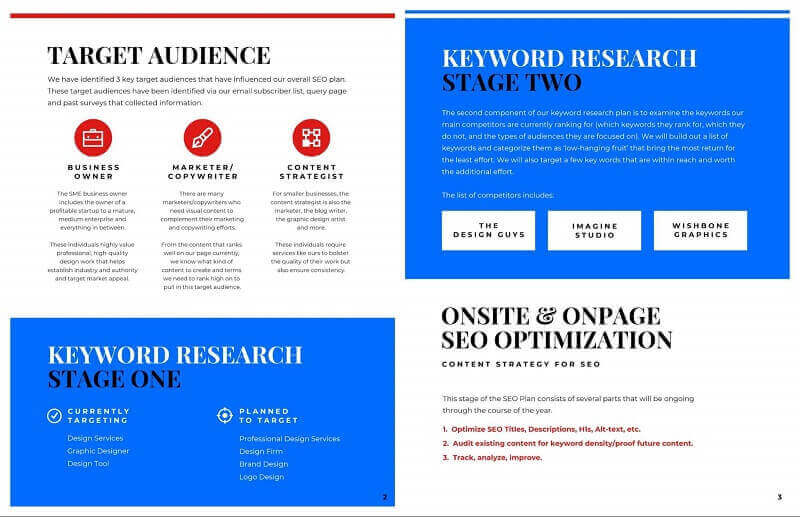
Breaking your strategy down into tasks will make it easier to tackle.
Another important way to visualize your marketing strategy is to create a product roadmap. A project roadmap visualizes the timeline of your product with individual tasks. Our roadmap maker can help you with this.
For example, this product roadmap shows how tasks on both the marketing and web design teams run parallel to each other:
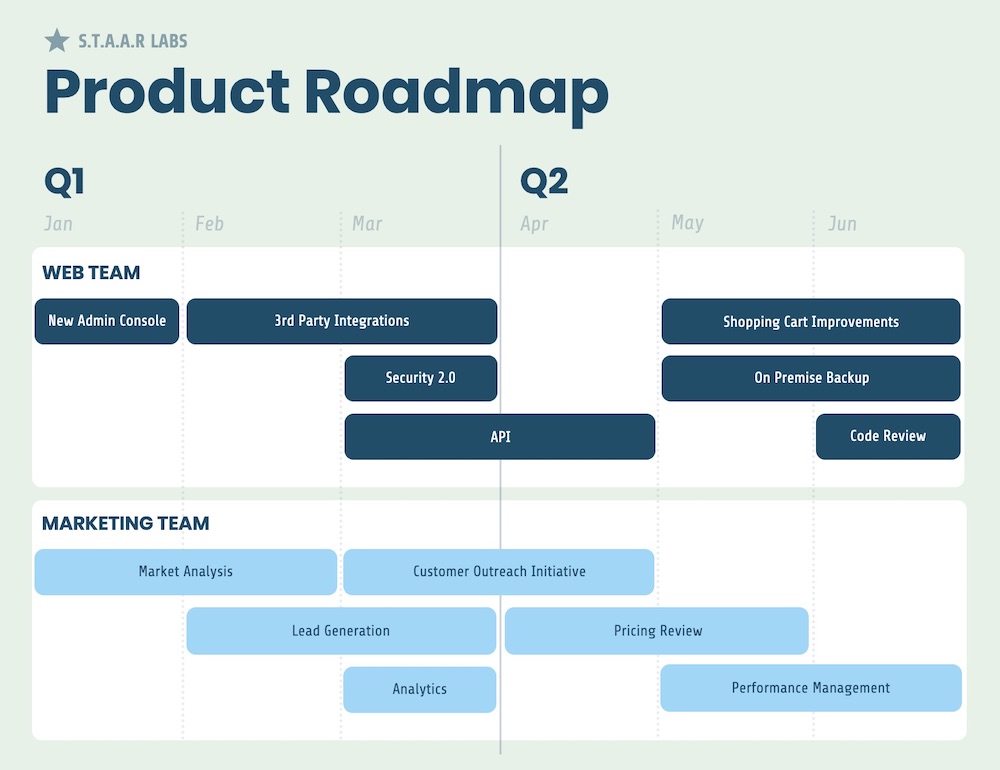
You can also use a simple timeline design in your marketing plan:
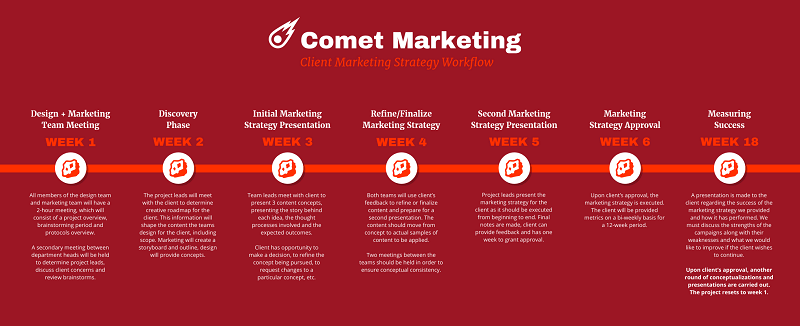
Even a simple “Next, Now, Later” chart can help visualize your strategy:

9. Set tracking or reporting guidelines
Close your marketing plan with how you’ll track results. Standardizing how you track results across your team will save you a lot of frustration down the line.
Like the other sections of your marketing plan, you can decide how in-depth you want to go. But you need to have a clear process on how to measure your markting plan’s progress and results.
At the bare minimum, the tracking guidelines should specify:
- What you plan to track
- How you will track results
- How often you will track them
You can add more tracking guidelines if you want. You may also want to include a template that your team or client can follow to ensure that you’re measuring the right metrics.

The marketing plan example below dedicates a whole page to tracking criteria:

Use a task tracker to monitor marketing results and a checklist maker to organize tasks, key events and daily activities.
The marketing plan example below talks about how to track social media marketing:

Marketing plan vs. marketing strategy
Although often used interchangeably, the terms “marketing plan” and “marketing strategy” do have some differences.
A marketing strategy presents what the business will do to reach a certain goal. It outlines the specific daily, weekly, monthly or yearly activities that the strategy calls for.
For example, you can create a proposal to implement the strategies that your marketing plan specifies. There are various marketing proposal examples that you can look at to help with this.
A company’s extended marketing strategy can look like a mind map:
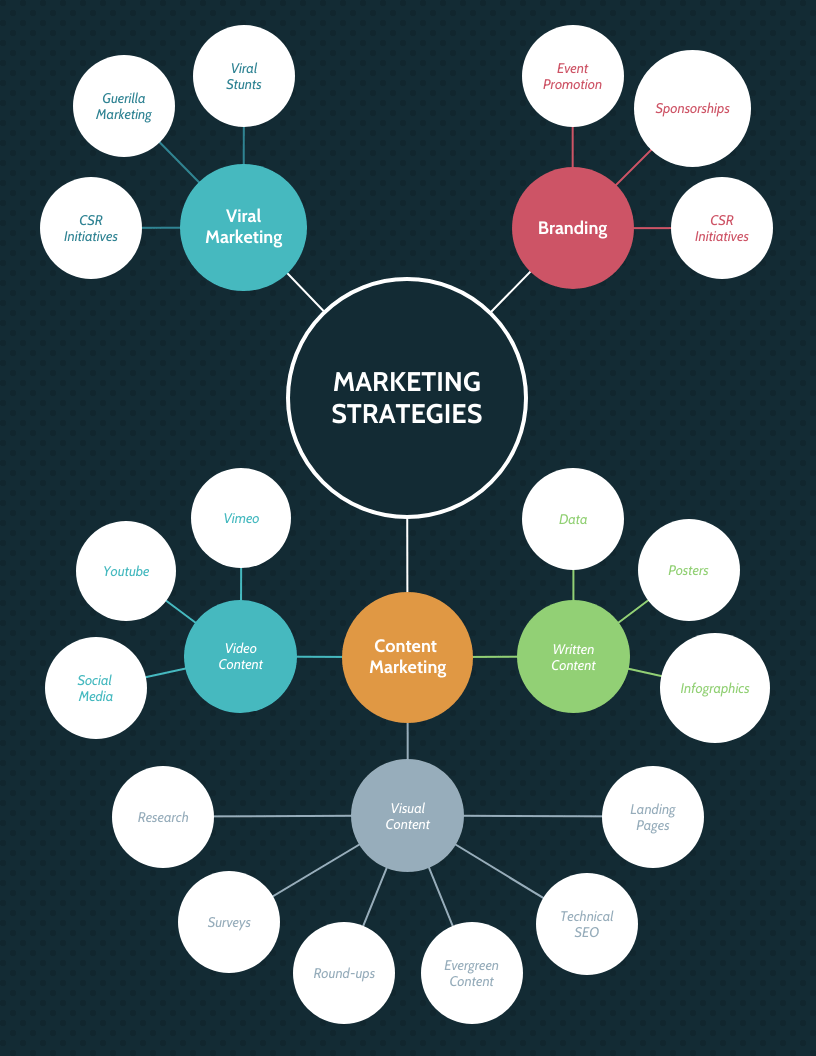
Notice how it’s more general and doesn’t include the actual activities required to complete each strategy or the timeframe those marketing activities will take place. That kind of information is included in a marketing plan, like this template below which talks about the content strategy in detail:

Marketing plan example: 9 templates and real-world samples
1. Nonprofit marketing plan
Here’s a free nonprofit marketing plan example that is ideal for organizations with a comprehensive vision to share. Not only does the plan outline the core values of the company, but it also shares the ideal buyer persona:

Notice how the consistent use of colors, fonts, and other design in this example reinforces the company’s identity, a key aspect of effective brand consistency. The content plan is an added incentive for anyone viewing the document to go ahead and give the team the green light.
Here’s an example of when this type of template works best. A charity raising awareness for mental health can use this template to visually highlight its mission, impact statistics and donor personas in its marketing campaigns to make its cause more compelling.
2. Social media marketing plan
Two-page marketing plan samples aren’t very common, but this template proves how effective they are. It has a dedicated section for business goals as well as for project planning:
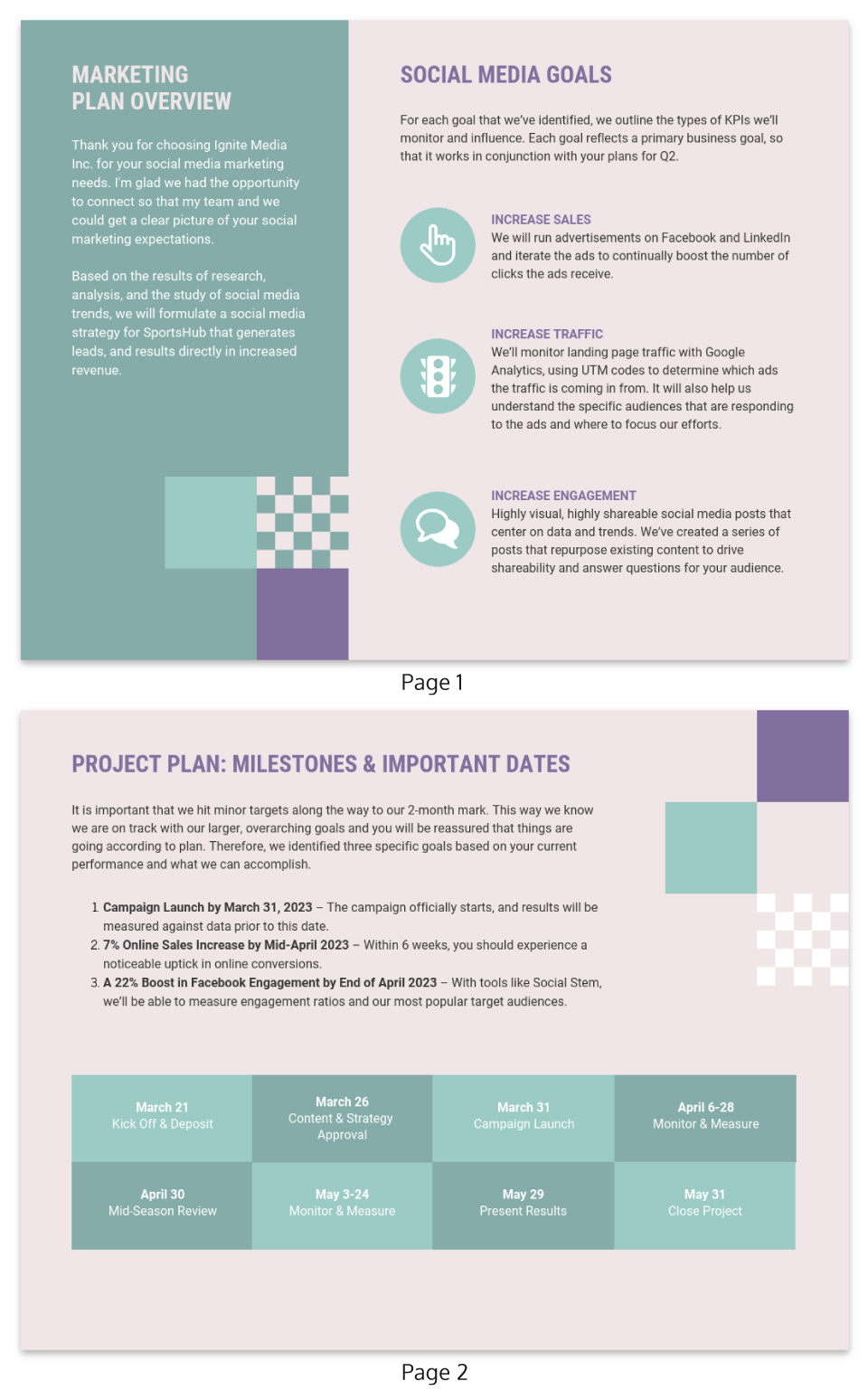
It clearly outlines the marketing campaign milestones, which shows how organized the strategy is.
For example, a startup that’s leveraging social media can use this template to map out content themes, engagement metrics and posting schedules at a glance for everyone in the team to see it.
3. Small business marketing plan
This marketing plan template is perfect for small businesses who set out to develop an overarching marketing strategy for the whole year:
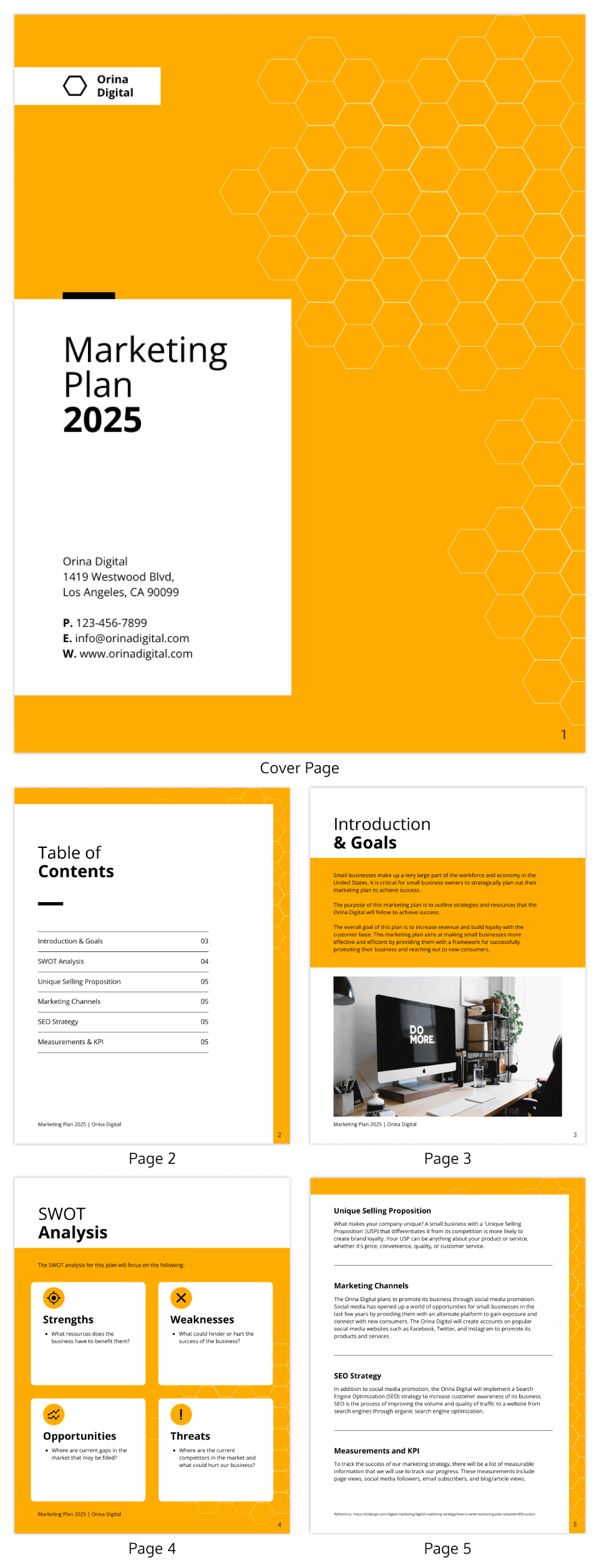
A local coffee brand can use design templates like this one to present SEO strategies with keyword maps, ranking progress and content plans in an easy-to-digest format.
Notice how the template closely aligns with the marketing plan outline we discussed in previous sections.
The template covers only SEO tactics for the marketing strategy, but you can expand it to include other strategies for a complete marketing plan.
4. Orange simple marketing proposal template
Marketing proposals like the one below effectively showcase your business strategy to attract potential customers:
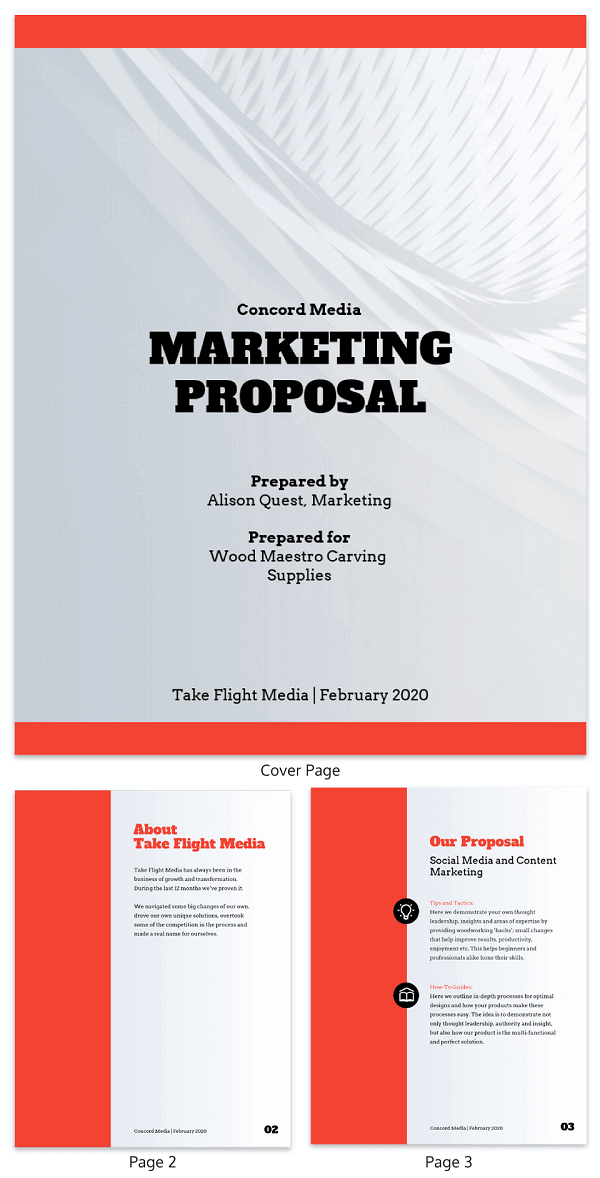
Want an example? A digital agency pitching a rebranding strategy can improve its marketing proposal with mood boards, logo variations, and brand colors.
5. One-page marketing plan
This one is perfect for showcasing marketing efforts in a persuasive presentation or printing it out for an in-person meeting:

Note how the fact sheet breaks down the marketing budget as well as the key metrics. An example of this can be an independent management consultant using a structured template like this to break down their pricing, highlight key services and present client testimonials for credibility.
6. Light company business fact sheet template
This template clearly outlines the marketing objectives for the organization. It’s a simple but effective way to share a large amount of information in short:

What really works with this example is that it includes a mission statement and key contact information alongside all the key metrics.
Here’s an example of where this template makes the most sense. Imagine a recently funded startup using this template to communicate its mission, key contact information and user growth metrics to the investors.
7. Marketing media press kit template
This press kit marketing plan template is bold and clearly identifiable as part of the Cloud Nine marketing agency. The strategic use of brand colors adds variety to each page layout and improves readability:

An online fashion retailer can use this press kit template to highlight media coverage, influencer collaborations and its brand story in a visually compelling way.
8. Professional marketing proposal template
Start your marketing campaign on a promising note with this marketing plan template. It’s short, sharp and to the point. The table of contents outlines the agenda and there’s a page for the company overview and mission statement:

A real estate firm can use this template to present its services, customer testimonials and projected outcomes with clean, professional visuals.
9. Social media marketing proposal template
A complete marketing plan example goes beyond just outlining business goals — it covers much more. Notice how the template below includes terms and conditions along with a payment schedule, making it one of the most comprehensive marketing plans on our list:

This template is also perfect for digital marketing agencies to showcase their engagement rates from recent campaigns, past customer testimonials or brand partnerships in a way that stands out to potential clients.
Marketing plan vs. business plan
While both marketing plans and business plans are crucial documents for businesses, they serve distinct purposes and have different scopes. Here’s a breakdown of the key differences:
A business plan is a comprehensive document that outlines all aspects of your business, including:
- Mission and vision
- Products or services
- Target market
- Competition
- Management team
- Financial projections
- Marketing strategy (including a marketing plan)
- Operations plan
A marketing plan, on the other hand, dives deep into the specific strategies and tactics related to your marketing efforts. It expands on the marketing section of a business plan by detailing:
- Specific marketing goals (e.g., brand awareness, lead generation, sales)
- Target audience analysis (detailed understanding of their needs and behaviors)
- Marketing mix (4Ps):
- Product: Features, benefits, positioning
- Price: Pricing strategy, discounts
- Place: Distribution channels (online or offline)
- Promotion: Advertising, social media, content marketing and public relations
- Budget allocation for different marketing activities
- Metrics and measurement to track progress and success
In short, business plans paint the entire business picture, while marketing plans zoom in on the specific strategies used to reach your target audience and achieve marketing goals.
Types of marketing plans that can transform your business strategy
Let’s take a look at several types of marketing plans you can create, along with specific examples for each:
1. General marketing strategic plan / Annual marketing plan
This is a good example of a marketing plan that covers the overarching annual marketing strategy for a company:

This one-page marketing plan example from Cengage has everything at a glance. Although a bit text-heavy and traditional, it explains the various sections well. The clean layout makes this plan easy to read and absorb:

Source: Cengage
The last marketing plan example we would like to feature in this section is this one from Lush Cosmetics.
It’s long but detailed. The plan outlines numerous areas, including the company mission, SWOT analysis, brand positioning, packaging, geographical criteria and much more:

Source: Calameo
2. Content marketing plan
A content marketing plan highlights different strategies, campaigns or tactics you can use for your content to help your business reach its goals.
This one-page marketing plan example from Contently outlines a content strategy and workflow using simple colors and blocks. The bullet points detail more information but this plan can easily be understood at a glance, which makes it so effective.

Source: Contently
check out this detailed content marketing plan template, which includes an editorial calendar to share with your entire team:

3. SEO marketing plan
Your SEO marketing plan outlines your strategy, including on-page optimization, AI-driven off-page tactics and link building. A rank tracker also helps monitor keyword performance and measure optimization impact.
This SEO marketing plan example discusses in detail the target audience of the business and the SEO plan laid out in different stages:

4. Social media marketing plan
Your social media marketing plan outlines how you’ll achieve your goals, including channel-specific tactics, new platform recommendations, and campaign strategies. For example, B2B brands often use LinkedIn automation to generate leads, while tech startups leverage X.com (formerly Twitter) to share latest company updates and stay abreast of industry conversations.
Edit this social media marketing plan example easily with Venngage’s drag-and-drop editor:

5. Demand generation marketing plan
This could cover your paid marketing strategy (which can include search ads, paid social media ads, traditional advertisements, etc.), email marketing strategy and more. To understand what’s truly driving results, marketers sometimes use marketing mix modeling—a method that measures the impact of each channel on overall performance. Here’s an example:

Marketing plan FAQs
What should marketing plans include?
In general, marketing plans should include:
- A detailed analysis of the target market and customer segments.
- Clear, achievable marketing objectives and goals.
- Strategies and tactics for product promotion and distribution.
- Budget allocation for various marketing activities.
- Timelines and milestones for strategy implementation.
- Evaluation metrics to track success and measure impact.
What is an executive summary in a marketing plan and what is its main goal?
An executive summary in a marketing plan is a brief overview of the entire document, summarizing the key points, goals and strategies. Its main goal is to provide readers with a quick understanding of the plan’s purpose and to entice them to read further.
What are the results when a marketing plan is effective?
When a marketing plan is effective, businesses can experience increased brand visibility, higher customer engagement, improved sales and revenue, through tools like dynamics 365 ERP and strengthened customer loyalty.
What is the first section of a marketing plan?
The first section of a marketing plan is typically the “Executive Summary,” which provides a concise overview of the entire plan, including the business’s goals and the strategies to achieve them.
Ready to create your marketing plan?
Here are more resources to help you explore marketing plans in depth:
- 25+ Marketing Plan Templates for Campaign Strategy
- 20+ Marketing Plan Infographics to Present Your Ideas
- 5 Marketing Proposal Examples to Elevate Your Business
- Marketing Roadmap: Examples, What It Is & How to Create One






































